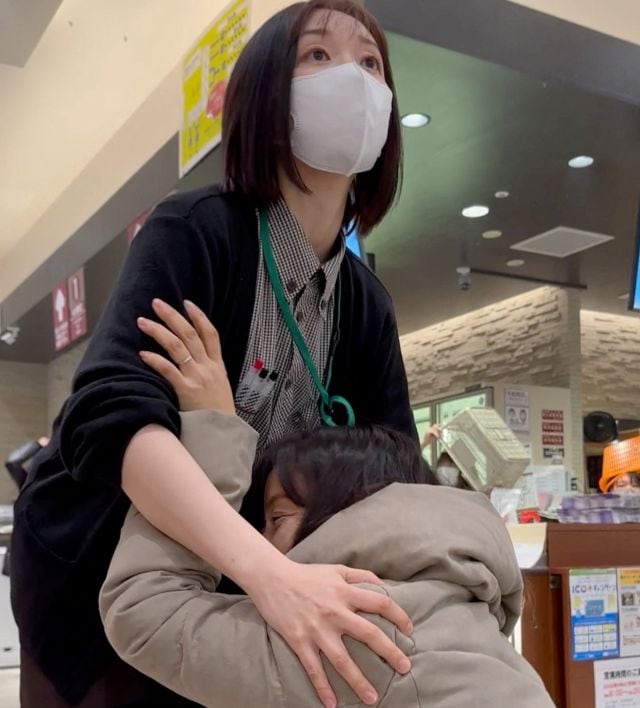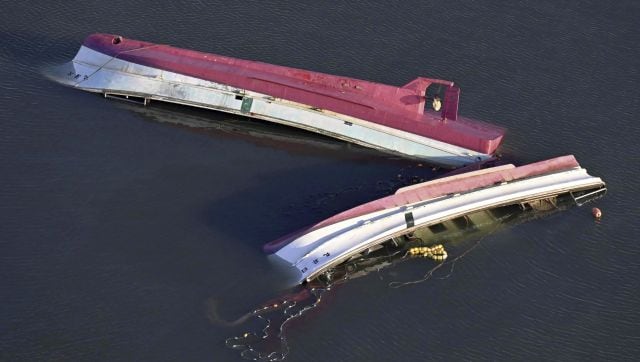New Year’s Day in Japan turned from happy to horrific in a matter of seconds when a powerful earthquake struck the region, and triggered tsunami waves over a metre high. The earthquake , measuring 7.6 on the Richter Scale and followed by several aftershocks, has wreaked havoc in Japan – shocking images show houses flattened to the ground, with abandoned cars being engulfed into huge crevices in the road. Japanese prime minister Fumio Kishida said in the aftermath of the quake, “The search and rescue of those impacted by the quake is a battle against time. We must rescue them as quickly as possible, especially those who are trapped under collapsed structures.” The quake on Monday also evoked memories of that horrific day in March 2011 when a massive 9.0-magnitude undersea quake occurred off northeastern Japan, triggering a tsunami that left around 18,500 people dead or missing. Now, as daylight breaks over Japan, the full destruction of the deadly earthquake is laid bare, showing collapsed homes, toppled temples and huge cracks in the middle of roads.
When the quake struck On Monday, the 7.6-magnitude earthquake struck around 16:10 local time at a depth of 10 kilometres (6 miles) in the Noto Peninsula of Ishikawa prefecture, according to the United States Geological Survey. According to the United States Geological Survey (USGS), at least 31 smaller aftershocks were reported near the region where the earthquake struck, with the agency saying that these
aftershocks could continue for days to months to follow. In fact, USGS seismologist Jessica Turner told CNN that of the 31 aftershocks, the largest was a magnitude 6.2 which occurred eight minutes after the initial earthquake. [caption id=“attachment_13565722” align=“alignnone” width=“640”] An aerial view shows a collapsed building caused by an earthquake in Wajima, Ishikawa prefecture. Reuters[/caption] The Japan’s meteorological office has been quoted as saying that a whopping 155 earthquakes have slammed the country in a day, causing extensive damage. Shortly after the quake, authorities in Japan also issued a
major tsunami warning for the coastal Noto area in Ishikawa, with authorities saying waves could reach heights of five metres (16 feet). However, the BBC reports that the waves that hit the coastline were not more than a metre high. And by nightfall, the major warning was downgraded to simply a warning, and then an advisory. Nearby Niigata and Toyama prefectures were also on alert. Several people in Japan have now recounted the moment when the quake first struck. One snowboarder in Japan’s Hakuba Alps told Reuters that his entire hotel room shook. He said it was common to hear about earthquakes in Japan, but “you wouldn’t expect to actually experience one”. [caption id=“attachment_13565732” align=“alignnone” width=“640”]
Road cracks caused by an earthquake is seen in Wajima, Ishikawa prefecture, Japan. Reuters[/caption] Andy Clark, a Briton in Japan, speaking to the BBC said that it was a “scary afternoon and evening”, as he was in the affected coastal city of Toyama when the quake hit. He “grabbed the sea wall to stay upright” before heading to a school roof for safety.
Please also read _In graphics | The science of earthquakes, explained_ _From Turkey to Nepal, the deadliest earthquakes that rocked the world_
Quake causes death and destruction The New Year earthquake has wreaked havoc in the region with news agency AFP reporting the death of eight people. However, this number has now risen to 13, with officials saying that the numbers will only climb. The scale of damage from the quake is still emerging, but the initial reports say it is utterly devastating. Thousands of houses have collapsed and roads across the country now bear huge cracks and crevices. Moreover, some 45,000 houses are without any power in Japan’s Ishikawa prefecture, according to the Hokuriku Electric Power company. [caption id=“attachment_13565742” align=“alignnone” width=“640”] Collapsed torii gate caused by an earthquake is seen at Onohiyoshi Shrine in Kanazawa, Ishikawa prefecture, Japan. AP[/caption] The defence ministry has already dispatched 1,000 military personnel to help the rescue and recovery efforts, Defense Minister Minoru Kihara told reporters Monday. In Suzu City, buildings were seen lying on their side while in Wajima City, at least 100 buildings have been reduced to rubble. In the latter, a major fire also broke out, burning more than 100 shops and houses. Japan’s public broadcaster NHK reported that the fire was still burning, with officials trying to bring it under control. The biggest of the quakes devastated Japan’s main island Honshu, with dozens reported trapped under rubble and tsunami warnings triggered in four countries in the aftermath. They were subsequently downgraded. Initially when the quake struck, about 1,400 passengers were also stranded inside in bullet trains, whose services were suspended. However, services resumed after 11 hours much to the relief of those stuck inside. NHK said there were no reports of anyone on the trains becoming ill during the wait. [caption id=“attachment_13565782” align=“alignnone” width=“640”]
 People sit on the floor inside a store as an earthquake hits, in Kanazawa, Ishikawa, Japan. Reuters[/caption] Hospitals in Ishikawa were on war-footing as a surge of people came in with injuries and the emergency rooms are expected to become even more crowded as rescue crews free people believed to be still trapped in the ruins of homes and buildings. There were also concerns about the nuclear plants in Japan. However, the Nuclear Regulation Authority said no irregularities were found at nuclear plants along the Sea of Japan, including five active reactors at Kansai Electric Power’s Ohi and Takahama plants in Fukui Prefecture. Hokuriku Electric’s Shika plant, the closest to the epicentre, had already halted its two reactors before the quake for regular inspections and saw no impact from the quake, the agency said. The quake has also wreaked trouble for travel plans – four expressways, two high-speed rail services, 34 local train lines and 16 ferry lines were halted, while 38 flights have been cancelled since the quake hit. [caption id=“attachment_13565792” align=“alignnone” width=“640”]
People sit on the floor inside a store as an earthquake hits, in Kanazawa, Ishikawa, Japan. Reuters[/caption] Hospitals in Ishikawa were on war-footing as a surge of people came in with injuries and the emergency rooms are expected to become even more crowded as rescue crews free people believed to be still trapped in the ruins of homes and buildings. There were also concerns about the nuclear plants in Japan. However, the Nuclear Regulation Authority said no irregularities were found at nuclear plants along the Sea of Japan, including five active reactors at Kansai Electric Power’s Ohi and Takahama plants in Fukui Prefecture. Hokuriku Electric’s Shika plant, the closest to the epicentre, had already halted its two reactors before the quake for regular inspections and saw no impact from the quake, the agency said. The quake has also wreaked trouble for travel plans – four expressways, two high-speed rail services, 34 local train lines and 16 ferry lines were halted, while 38 flights have been cancelled since the quake hit. [caption id=“attachment_13565792” align=“alignnone” width=“640”] Fishing boats are overturned at a port in Shikamachi, Ishikawa prefecture, Japan. AP[/caption] Racing to rescue survivors Shortly after the quake struck,
rescue operations have begun with the military being despatched. Prime Minister Fumio Kishida said, “I instructed (emergency workers) to reach the area as soon as possible by using whatever means available. Saving lives is our priority and we are fighting a battle against time. “It is critical that people trapped in homes get rescued immediately.” Government spokesman Yoshimasa Hayashi has also stressed that it was critical for people to move away from coastal areas. “Every minute counts. Please evacuate to a safe area immediately,” he said. People who were evacuated from their houses were huddled in auditoriums, schools and community centres. [caption id=“attachment_13565802” align=“alignnone” width=“640”]
Fishing boats are overturned at a port in Shikamachi, Ishikawa prefecture, Japan. AP[/caption] Racing to rescue survivors Shortly after the quake struck,
rescue operations have begun with the military being despatched. Prime Minister Fumio Kishida said, “I instructed (emergency workers) to reach the area as soon as possible by using whatever means available. Saving lives is our priority and we are fighting a battle against time. “It is critical that people trapped in homes get rescued immediately.” Government spokesman Yoshimasa Hayashi has also stressed that it was critical for people to move away from coastal areas. “Every minute counts. Please evacuate to a safe area immediately,” he said. People who were evacuated from their houses were huddled in auditoriums, schools and community centres. [caption id=“attachment_13565802” align=“alignnone” width=“640”] Fire burns following an earthquake at a residential area in Wajima, Ishikawa prefecture, Japan. Reuters[/caption] Promise of help The United States quickly issued a statement, assuring Japan of help. “My administration is in touch with Japanese officials, and the United States stands ready to provide any necessary assistance for the Japanese people,” President Joe Biden said. Prime Minister Rishi Sunak said the United Kingdom, too, was “ready to support Japan” following the disaster, and that his thoughts were with “all those affected by the earthquakes in Japan which have caused such terrible damage.” The
Indian Embassy in Japan has set up an emergency control room for anyone to contact in connection with an earthquake and tsunami that hit the island nation. In a press statement, the Embassy released emergency numbers and email IDs that can be contacted for assistance and relief. With inputs from agencies


)

)
)
)
)
)
)
)
)



